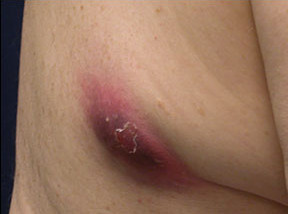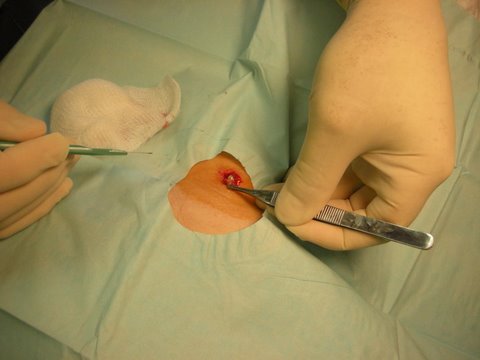A sebaceous or epidermal cyst is a lump that forms in the outermost layer (epidermis) of your skin. It develops when an oil-producing (sebaceous) gland in your skin is blocked, creating a hollow sac filled with fatty, yellowish substance that looks like cottage cheese. These cysts often consist of swollen hair follicles or lumps that result from skin trauma. Sebaceous cysts are usually harmless, but an infected sebaceous cyst can be a problem.
Symptoms of Infected Sebaceous Cyst
 A sebaceous cyst is a movable, painless bump that is often slow-growing under your skin. However, sometimes, it can become infected due to trauma or repeated contact with bacteria from your hands. Typical signs and symptoms of an infected sebaceous cyst include tenderness, redness, hot feeling over the affected skin, and fluid with waxy and oily appearance. As for the common epidermal cysts, you can also drain cheesy and grayish white stuff with bad smell from the lump.
A sebaceous cyst is a movable, painless bump that is often slow-growing under your skin. However, sometimes, it can become infected due to trauma or repeated contact with bacteria from your hands. Typical signs and symptoms of an infected sebaceous cyst include tenderness, redness, hot feeling over the affected skin, and fluid with waxy and oily appearance. As for the common epidermal cysts, you can also drain cheesy and grayish white stuff with bad smell from the lump.
Call your doctor if any of these symptoms occur:
- Increased redness around the affected area
- Worsening swelling and pain
- High fever (100.4°F/38ºC or higher)
- Pus draining from the cyst
Can Infected Sebaceous Cyst Be Serious?
Usually, this condition causes no serious issues. Infected sebaceous cyst need to be removed to prevent any further problems. While for sebaceous cysts that are not infected, a removal is not a must, because some cysts disappear with warm compress treatment or go away on their own.
If your cyst ruptures, you will experience symptoms like an infected boil and you need immediate treatment. In addition, an infected sebaceous cyst can be very painful and swollen. It may be difficult to operate on, so your doctor may advise you to wait till the inflammation decreases. Fortunately, no complications occur after surgical drainage or cyst removal in most cases. However, some people also report that sebaceous cysts can sometimes reappear. Therefore, proper post-surgery care should be followed.
Medical Treatment for Infected Sebaceous Cyst
 1. Antibiotics
1. Antibiotics
Your doctor will probably prescribe antibiotics such as Flucloxacillin to treat your infected sebaceous cyst, which you should take as directed. You may feel better after a few days, but you will be advised to continue finishing the whole course.
2. Get Surgery
 Surgical removal of the cyst is sometimes necessary. If the cyst is small with less severity, your doctor will then apply a lance to drain and remove the cyst. For relatively larger cysts, the doctor will cut in oval from both sides or on the center to remove the cyst. Don't worry about the pain, because a local anesthetic will be administered around the area to prevent you from experiencing any pain.
Surgical removal of the cyst is sometimes necessary. If the cyst is small with less severity, your doctor will then apply a lance to drain and remove the cyst. For relatively larger cysts, the doctor will cut in oval from both sides or on the center to remove the cyst. Don't worry about the pain, because a local anesthetic will be administered around the area to prevent you from experiencing any pain.
3. Post-Surgery Care
The most important thing to do after your surgery is to keep the area clean. There will be no complications, as long as you do not touch your wound unnecessarily. If the sutures are dissolvable, you will not need to go back to for removal of sutures.
In addition, herbal cleansing can be applied to help faster healing. Guava leaves can be boiled in water to make antiseptic wash for you wound. Remember to cool the solution before using. In addition, aloe vera leaves with thick and soothing sap can be directly used on the wound, then just leave the sap on the wound and let dry. One thing to remember is to test any homemade remedy on the skin before using to avoid any allergic reaction.
Home Remedies for Sebaceous Cyst

1. Warm Compress
How it helps: Moist heat promotes blood circulation to your infected sebaceous cyst and speeds up healing process. A warm compress dilates the blood vessels and improves transport of nutrients to the area so that damaged tissues heal faster. It also helps wash out toxins and debris causing inflammation.
How to apply:Soak a small towel in warm water. Wring the towel to get rid of excess water. Apply the warm towel over your cyst for 10-20 minutes. Do this two to four times daily.
2. Tea Tree Oil
How it helps:Tea tree oil helps reduce the formation of recurrent sebaceous cysts. It is a known antimicrobial agent that has great anti-bacterial and anti-inflammatory effects.
How to apply: Place one to two drops of tea tree oil on your infected sebaceous cyst. Cover with band-aid. Take off the Band-Aid after 8 to 10 hours and avoid sleeping with the band-aid on at night. You can repeat this process in the next morning.
3. Castor Oil
How it helps:Castor oil counters itching and inflammation. It has a chemical called ricin which has anti-bacterial properties.
How to apply: First, soak a clean piece of cloth in castor oil, then cover the cyst and place a warm compress. Hold for about half an hour. You can also gently rub some castor oil over your cyst a few times daily.
4. Aloe Vera
How it helps:Aloe vera is a popular home remedy that not only benefits the skin but your general health as well. With anti-bacterial property, it can relieve pain and skin discomfort caused by an infected sebaceous cyst. As mentioned above, aloe vera helps to speed up the wound healingprocess.
How to apply: Apply some aloe vera gel directly on your sebaceous cyst. Gently rub onto the area to help the gel penetrate into the cyst. Do this once or twice a day.
5. Apple Cider Vinegar
How it helps: Apple cider vinegar is known for its strong antiseptic, anti-bacterial, and anti-fungal properties. It is an effective cleansing agent that helps get rid of bacteria in wounds.
How to apply: Soak a cotton ball in some apple cider vinegar and then apply it to your cyst. Let it stay for some time before removing. If you experience a stinging sensation, dilute with some water to make a solution and use it on the cyst. Do this three to four times daily.
